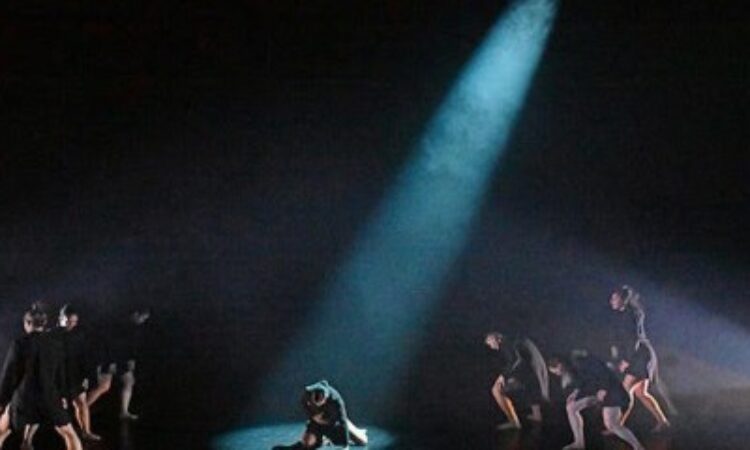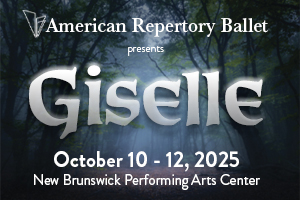In the theatrical smoke of the FringeArts, a contemporary performance space in the Old City of Philly, I witnessed an artistic fusion that integrates traditional and modern, folk and urban cultures. Mirroring the historical brick rowhouses, modern galleries, and communicative function of the Benjamin Franklin Bridge, Kun-Yang Lin/Dancers’ 2024 Home Season at the FringeArts presented masterworks that traverse culture and time.
As the highlight of the performance, Kun-Yang’s 30-minute world premiere “Breath into Air” covers the second half of the concert. The kinesthetic empathy created by the virtuoso moving and breathing dancers of the KYL/D ensemble evokes feelings of familiarity, alienness, and healing. The grim first section begins within a busy signal of a disconnected phone call. Nine dancers in black shirts grab their tight collars and desperately gasp for breath. Their rhythmic breath builds into a pattern and merges with Cory Neale’s electronic music. The fear on their faces and the cramping bodies are reminiscent of the distance, panic, and uncertainty during the pandemic.
The emphasis on the dancers’ sound of breathing, which has become a unique method in Kun-Yang’s choreography, aurally conducts the energy flowing between movements and coincides with the theme of the piece. To provide an opportunity to reflect on what life, death, and loss mean to us, “Breath Into Air” finishes with an optimistic ending: striding across the floor, dancers slowly unbutton their shirts to reveal the glittery beads on their biketards; the silvery bell-sound in the music like sparkling sunlight on the sea brings delightful leaps and bright smiles of the dancers; their shadows on the white backdrop triple the number of the dancing bodies and create an effect of a steady stream of people. As an audience, I kinesthetically feel the fluid breath of the dancers and their unbreakable vitality. As Kun-Yang says before the show, “We should be senseful and grateful for every moment and every breath.”
The first half of the concert began with two neat pieces: “Dragon” (2023) and “Koyl” (2016) choreographed by KYL/D senior dancers Weiwei Ma and Evalina Carbonell respectively. Ma’s “Dragon” draws upon the minimalist aesthetic of Yuyu Yang’s stainless-steel sculpture “Dragon’s Shrill in the Cosmic Void” (1991), in which seven dancers only wear skin-toned shorts or leotards to highlight their muscularity and movements in unison. As individuals, their gestural arms and sweeping legs shift between qualities of sharpness and stillness, which is reminiscent of talented martial artists who sophisticatedly control their speed of fight. As a group, the dancers’ unified stomp and canonic spiraling in a line make each of them a vertebra of a dragon spine that transfers the energy and rave of the dancing dragon. Through embodying the mythology dragon in Chinese traditional legend, Weiwei innovatively investigated the relationship between individuals and the collective.
In Carbonell’s duet “Koyl,” she and Ma dress in flowy lavender transparent robes and narrate the struggle and empathy between females. Throughout the dance, however, the goddess-like costume does not help their virtuoso bodies in executing the tension and violence expressed in the program note. What brings feminist empathy back to the stage is the delicate ending, in which the dancers simply walk on the edge of a square spotlight and the gradual zoomed-out square takes them closer to each other and meets in the eyes.
The last piece before the intermission showcases Kun-Yang’s reimagined Mandala Project (2011). Within the heavy wind and percussive sound of Tibetan music, dancers determinedly walk onto the stage one at a time by cladding in blood-red traditional Chinese Tang suits. Their eyes slightly lowered and hands sealed together in front of their bodies. By keeping a canon pattern, the dancers accelerate their steps and spread out of the stage along with the rapidly shifting hand gestures drawn from Buddhist mudras. The sacred atmosphere is highlighted by the Mandala offering solo (performed by Keila Pérez-Vega on Friday and Weiwei on Saturday), where the dancer’s stillness in symmetrical gestures and sharpness in changing mudras are emphasized. Towards the end of the piece, a big spiraling mandala flower appears on the white backdrop, echoing the dancers’ circular formation and their rotating energy within the community.
To celebrate KYL/D’s 26th anniversary, the artists’ eight months of hard work crystallized the 90-minute concert. As a unique dance company in Philly, KYL/D’s works continuously experiment with Asian cultural heritage in contemporary dance. Kun-Yang’s new piece “Breath Into Air,” however, furthers the possibility of traversing cultural boundaries by exploring a collective human consciousness.






